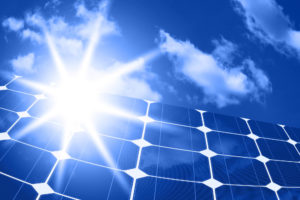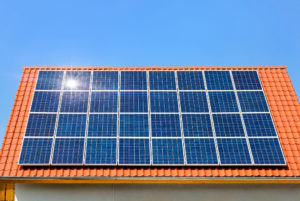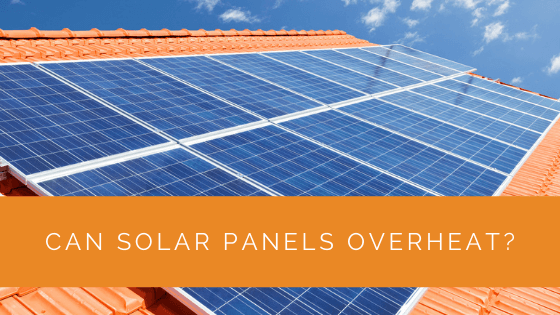Solar panels are associated with the sun and the energy we get from it. It is no surprise that we assume they can tolerate any amount of heat. Most people also believe that the more the heat, the better the energy production by solar panels. However, this is definitely not the case.
While solar panels draw energy from the sunrays, it is not the heat they require. The heat energy provided by the sun is entirely useless for most solar panels. Photovoltaic cells present on the surface of the panels only use light energy or photons to make electricity.
High temperatures can be terrible for solar panels and their efficiency in producing electricity. So, when it comes to whether or not solar panels overheat, the answer is yes. They can overheat under high temperatures. Continue reading to learn more about the effect of heat on solar panels!
Contents
- 1 Key Takeaways
- 2 Do Solar Panels Overheat?
- 3 What Are The Performance Checks Solar Panels Go Through?
- 4 How Does The Temperature Affect Solar Panels?
- 5 What Is The Temperature Coefficient?
- 6 Can Solar Panels Work In Hot Regions?
- 7 How To Manage Your Solar Panels In Hot Climates?
- 8 Case Study: Ensuring Optimal Solar Panel Performance in High-Temperature Environments
- 9 Expert Insights From Our Solar Panel Installers About Can Solar Panels Overheat?
- 10 Experience Solar Excellence with Us!
- 11 In Conclusion
Key Takeaways
- Solar panels can overheat under prolonged exposure to very high temperatures, which can significantly reduce their efficiency in producing electricity.
- The efficiency of solar panels is affected by temperature changes, with lower temperatures being more favorable for higher power output.
- Solar panels in hot regions can still work, but their efficiency may gradually decrease over time. Proper maintenance and choosing panels with low-temperature coefficients can help mitigate the impact of heat on their performance.
Do Solar Panels Overheat?
Yes, solar panels do overheat under prolonged exposure to very high temperatures outside. It is a common misconception among people that high temperatures and perpetually sunny climates equate to increased energy production by solar panels.
Such climatic conditions are a major cause of why most solar panel set-ups malfunction. You will notice a significant drop in the efficiency of your solar panel set-up if the temperature outside is too high or it is too sunny.
PV or photovoltaics are the most common type of solar panels people install in their homes or offices. However, high temperatures are not ideal for such set-ups. If you live in a region where the heat of the sun is excruciating, you might want to explore your solar panel options first.
Photovoltaics are put through a series of quality and standard checks before being sold to customers. Two separate parameters of tests determine the overall efficiency of PV modules. These tests, however, fail to estimate the way panels will react to real-life conditions.
What Are The Performance Checks Solar Panels Go Through?
STC or Standard Test Conditions and NOTC or Nominal Operating Cell Temperature are the two performance checks that tell us about the efficiency of solar panels and their power outputs.
Test conditions or parameters set for both STC and NOTC:
STC:
- Irradiance = 1kW/m2
- Temperature = 25°C
- Air Mass = 1.5 AM.
NOTC:
- Irradiance = 800 W/m2
- Wind Speed = 1 m/s
- Ambient Temperature = 20°C
- Surface Temperature = 45°C
It is clear to see that STC does not consider surface temperatures. Therefore, it is not as realistic a test as NOTC. The surface temperature or ambient temperature in NOTC is kept at 45 degrees to test how a panel will perform in real-life conditions.
STC fails to estimate real-life values. Checking a solar panel’s performance at 25°C or an ideal temperature is not enough. However, most solar panels or photovoltaics are tested using STC only.
The efficiency of energy conversion, power output, and overall performance of most solar panels depends on how it performs in STC conditions. This is one of the most important reasons most solar panels fail to perform well in scorching climates.

How Does The Temperature Affect Solar Panels?
Highly durable materials are used to make the external surface of the solar panels. These panels can withstand extreme weather conditions, right from sub-zero temperatures to scalding hot climates. However, temperature changes can severely affect the efficiency and power outputs of your solar panel set-ups.
The temperature has a direct effect on the voltage of cells. The voltage further affects the power output of the solar panels. However, in most PV set-ups, the values of current transferred are rarely affected due to the temperature changes.
We know that the lower the temperature, the higher will be the voltage given by solar panels. Similarly, you will notice a dip in your voltage levels once the temperature begins to rise. This relation helps us estimate the efficiency of solar panels.
Since P=VxI, where P=Power, V=Voltage, I=Current, we can estimate the amount of power generated and the overall efficiency of the panel very easily. Upon calculation, it is evident that lower temperatures are going to be beneficial for the power output.
What Is The Temperature Coefficient?
Too much heat cripples the ability of a solar panel to convert solar energy to electrical energy. The laws of thermodynamics come into play, and the amount of electricity produced by the panels decreases significantly.
This effect of heat on the solar panel’s ability to produce power is calculated in digits to estimate the temperature coefficient of every panel. The value is the amount of power output reduced (in percentage) per every 1-degree rise in the temperature after 25°C.
Most solar panels work with the highest efficiency at 25°C. So, when you calculate their temperature co-efficient, you calculate how effective they will be overall in real-life settings.
For instance, panel ‘A’ has a temperature coefficient of 0.40%. So, we can estimate that the efficiency of this panel will reduce by 0.40% with every 1-degree rise in temperature after 25°C.
Here is a list of some common temperature co-efficient values of popular solar panel brands.
| Solar Manufacturer | Temperature Coefficient Range (In percentage) |
|---|---|
| Q Cells | -0.42 To -0.37 |
| Hyundai | -0.45 To -0.41 |
| LG | -0.42 To -0.3 |
| SunPower | -0.38 To -0.29 |
| Panasonic | -0.3 To -0.29 |
Can Solar Panels Work In Hot Regions?
While most solar panels are built in a way that enables them to withstand extreme climates, too much heat can deteriorate your panel’s efficiency over time.
Heat and humidity can physically damage your solar panels too. Solar panels that are exposed to humidity for long periods can begin to accumulate moisture. Apart from this, the panels could also experience delamination and a drop in current.
Solar panels installed on roofs are even more susceptible to heat damage. This is because your solar panel will be in direct contact with the sun’s heat at all times. The undersurface of your solar panels will get overheated in the summers if there isn’t enough air circulation available.
Heated panels will begin to malfunction eventually. You will experience a drop in power output, voltage, and the performance of your set-up.
So, is it viable to use solar panels in perpetually hot regions? The answer is yes; you can use solar panels anywhere there is sunlight. However, the PV cells will gradually lose their ability to retain solar energy.
In some cases, the solar panels in hot regions can be beneficial. If you have solar panels on your roof, the sunlight will hit the panels first. They will convert it into electricity and do not allow much of the sun’s heat to reach your roof. Thus, your home will not heat up as much.

How To Manage Your Solar Panels In Hot Climates?
It is possible to set up solar panels anywhere. However, before setting them up, you must take note of where you live. While most PV set-ups can handle increased temperatures during the summer months, if you live somewhere where high temperatures persist all year round, you might need professional help and guidance.
You must consult with professionals before installing solar panels on your premises. The process can be lengthy and even a little pricy at first. However, you will certainly get your returns on this investment if you do it right.
One thing you can be mindful of while buying a solar panel is its temperature coefficient. This value is inversely related to the amount of effect temperature has. It would be best if you opted for low-temperature coefficient panels like the HIT modules from Panasonic.
Additionally, to reduce the efficiency loss in your region, you will have to clean up the solar panels as necessary. Given that most hot climates are near deserts, the accumulation of dust and debris is common.
Clean up your solar panels if you notice dust and debris collecting on their surface. You can also seek professional help for the same. Moreover, regular maintenance of solar panel set-ups is one of the best ways to maintain the efficiency of your solar panels.
Case Study: Ensuring Optimal Solar Panel Performance in High-Temperature Environments
Background
At Solar Panels Network USA, we often encounter clients living in regions with extreme temperatures who are concerned about the efficiency and longevity of their solar panel installations. One such client, residing in a particularly hot area, approached us to install a solar energy system on their property.
Project Overview
The client needed a solar solution that would perform efficiently despite the high temperatures. Our task was to design and implement a system that minimized efficiency losses due to heat and provided consistent power output.
Implementation
We began by conducting a thorough site assessment to understand the specific environmental challenges. Using our findings, we selected solar panels with a low temperature coefficient, such as Panasonic HIT modules, known for their superior performance in high temperatures. These panels were chosen for their ability to maintain higher efficiency levels even when the ambient temperature rises.
To further combat the heat issue, we designed an installation plan that ensured ample air circulation around the panels. We utilized elevated mounting systems to create a gap between the roof and the panels, allowing air to flow freely and cool the panels naturally.
We also incorporated a regular maintenance schedule into the client’s service plan. Given the area’s propensity for dust and debris, we emphasized the importance of keeping the panels clean to prevent any additional heat buildup. Our team provided training to the client on how to safely and effectively clean the panels, and we scheduled periodic professional cleanings as part of our service agreement.
Results
The installed system exceeded the client’s expectations. Despite the high temperatures, the solar panels consistently produced optimal power output, demonstrating the effectiveness of our chosen solutions. The elevated mounting system proved successful in maintaining lower panel temperatures, and the regular cleaning regimen ensured that dust and debris did not impact efficiency.
The client reported a significant reduction in their electricity bills and expressed satisfaction with the system’s performance. The professional guidance and tailored maintenance plan we provided gave them confidence in their investment, knowing that their solar energy system would continue to operate efficiently even in the harshest conditions.
Summary
This case study highlights the importance of selecting the right solar panels and implementing strategic installation and maintenance practices in high-temperature regions. At Solar Panels Network USA, we combine advanced technology with expert knowledge to deliver solar solutions that stand up to environmental challenges. By choosing panels with a low temperature coefficient, ensuring proper airflow, and maintaining cleanliness, we help our clients achieve maximum efficiency and long-term performance from their solar installations.
Expert Insights From Our Solar Panel Installers About Can Solar Panels Overheat?
High temperatures can indeed affect solar panel efficiency. It’s crucial to choose panels with a low temperature coefficient if you live in a hot region to ensure optimal performance throughout the year.
Senior Solar Technician
Proper installation and maintenance can mitigate overheating issues. Ensuring good air circulation around the panels can help dissipate excess heat and maintain efficiency.
Lead Solar Installer
Regular cleaning is essential in hot climates, especially in areas prone to dust and debris. Accumulated dirt can exacerbate heat retention and further reduce panel efficiency.
Solar Maintenance Specialist
Experience Solar Excellence with Us!
Trust in Solar Panels Network USA, where our seasoned experts deliver top-quality solar solutions for homes and businesses nationwide. With a legacy of countless successful installations and a commitment to sustainable energy, we’re your reliable partner in the solar journey. Ready for a brighter, eco-friendly future? Call us now at (855) 427-0058 and harness the power of the sun!
In Conclusion
Solar panels can have a tough time adapting to high temperatures. In such cases, getting professional help might be your best bet. When you consult with experts like Solar Panel Network USA, you will know exactly which solar panel is the one for you.
So, without any further delay, contact Solar Panel Network USA today and learn more about the solar panel best suited for your requirement!
About the Author
Solar Panels Network USA stands at the forefront of solar energy solutions, driven by a team of seasoned solar engineers and energy consultants. With over decades of experience in delivering high-quality solar installations and maintenance, we are committed to promoting sustainable energy through customer-centric, tailored solutions. Our articles reflect this commitment, crafted collaboratively by experts to provide accurate, up-to-date insights into solar technology, ensuring our readers are well-informed and empowered in their solar energy decisions.

